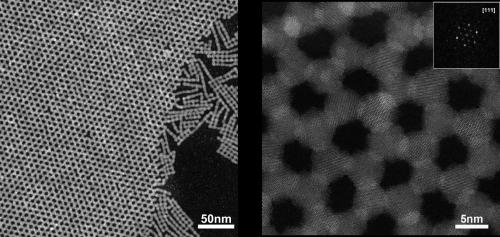- Home
- News
- General News
- Honeycomb ‘artificial...
Honeycomb ‘artificial graphene’ nanocrystal structure studied at the ESRF
02-06-2014
An international team of researchers has studied a new material at the European Synchrotron, the ESRF, which sees nanocrystals, or artificial atoms, arranging themselves in an orderly way to form a honeycomb structure. A recent theoretical description of such a material suggested it could be useful in areas such as opto-electronics - in touch screen devices or LEDs for example - and in quantum computing. The results from a consortium from the Netherlands, Belgium and the ESRF, are published in Science.
Share
Using X-rays at the ESRF, the team, led by Professor Daniel Vanmaekelbergh from the University of Utrecht in the Netherlands observed the nanocrystals aligning and then bonding into a honeycomb structure similar to that of graphene with the exception that the building blocks forming the structure are not carbon atoms but much larger nanocrystals. The unique property of the honeycomb structure is that it allows the electrons to move through the material as if they have no mass, allowing them to travel with a remarkably high and constant speed of more than a million kilometres an hour. It is predicted that ‘artificial graphene’ made of nanocrystals has similar electronic properties.
The prominent components inside the nanocrystal honeycomb structure are lead selenide and cadmium selenide semiconductor nanoparticles. The advantage of using nanocrystals as artificial atoms stems from the fact that their properties can be tuned by tailoring their size and composition. This adds a large degree of flexibility to the already impressive electronic properties of graphene.

High resolution electron microscope images of the artificial honeycomb structure. The atomic contrast in the right image and the electron diffraction pattern (top right) show that the attached nanocrystals are atomically aligned, and thus form a single crystalline structure.
Recent ESRF experiments shed light on how this novel material is being formed:
"The trick that we played, is combining the tuneable properties of nanocrystals with the special effects taking place in a honeycomb structure", says Professor Vanmaekelbergh. "This allows for the design of a material with truly unique properties."
"The question with regard to this artificial honeycomb was how the material is actually formed", explains PhD student Mark Boneschanscher from the University of Utrecht. "By combining a large number of different analysis techniques we could resolve the structure on both the atomic and nanometre scale”. By merging this information with the structure of the individual nanocrystals, scientists could predict the mechanism of attachment of the nanocrystals, giving a first indication of how the honeycomb structures are formed.
For a complete analysis of the structure it was important to relate the atomic structure to the nanoscale structure. High resolution electron microscopy images provided the researchers with detailed local scale information. For a large scale analysis, the researchers turned to beamline ID01 at the ESRF, where a combination of small-angle and wide-angle scattering showed how the atomic crystal structure was aligned with the nanoscale honeycomb periodicity.

GISAXS pattern obtained at beamline ID-01. A linescan along qy shows the typical scattering pattern from the hexagonal structure of the holes in the honeycomb structure. Credit: M.P. Boneschanscher.
As a next step in the research, the team will study the formation of the honeycomb supercrystal in situ on the liquid-air surface. Here the ESRF, which provide a possibility for in-situ access to atomic and nanometre structure, will inevitably play an important role. A recently established joint PhD project will facilitate further studies.
Notes to Editors
References for the paper are as follows:
Long-Range Orientation and Atomic Attachment of Nanocrystals in 2D Honeycomb Superlattices, M.P. Boneschanscher, W.H. Evers, J.J. Geuchies, T. Altantzis, B. Goris, F.T. Rabouw, S.A.P. van Rossum, H.S.J. van der Zant, L.D.A. Siebbeles, G. Van Tendeloo, I. Swart, J. Hilhorst, A.V. Petukhov, S. Bals, and D. Vanmaekelbergh, Science, 29 may 2014.
The link to the paper can be found on the Science website.
Contacts
For more information please contact Professor Daniel Vanmaekelbergh:d.vanmaekelbergh@uu.nl. Tel: +31 30 253 2218.
Media contact: Lucy Stone, ESRF Communications Manager: lucy.stone@esrf.fr. Tel: +44 476 882087.
Top image: Block models of the honeycomb structure formed from truncated cubic nanocrystals attached in an atomic coherent fashion in the top (left) and side (right) view. Credit: M.P. Boneschanscher.



